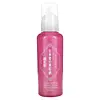What's inside
What's inside
 Key Ingredients
Key Ingredients

 Benefits
Benefits

 Concerns
Concerns

No concerns
 Ingredients Side-by-side
Ingredients Side-by-side

Water
Skin ConditioningButylene Glycol
HumectantGlycosyl Trehalose
Emulsion StabilisingHydrogenated Starch Hydrolysate
HumectantRice Ferment Filtrate
Skin ConditioningGlutamic Acid
HumectantArginine
MaskingGlycine
BufferingAspartic Acid
MaskingSerine
MaskingValine
MaskingProline
Skin ConditioningIsoleucine
Skin ConditioningThreonine
Histidine
HumectantAlanine
MaskingPhenylalanine
MaskingCeramide EOP
Skin ConditioningCeramide NP
Skin ConditioningCeramide AP
Skin ConditioningAscorbyl Glucoside
AntioxidantMagnesium Ascorbyl Phosphate
AntioxidantPlacental Protein
HumectantArbutin
AntioxidantDipotassium Glycyrrhizate
HumectantBetaine
HumectantSqualane
EmollientTriethylhexanoin
MaskingIsostearic Acid
CleansingPhytosteryl/Octyldodecyl Lauroyl Glutamate
Skin ConditioningCholesterol
EmollientPhytosphingosine
Skin ConditioningSodium Lactate
BufferingPCA
HumectantSodium PCA
HumectantSodium Lauroyl Lactylate
EmulsifyingPolysorbate 60
EmulsifyingPolysorbate 20
EmulsifyingPEG-60 Hydrogenated Castor Oil
EmulsifyingCarbomer
Emulsion StabilisingXanthan Gum
EmulsifyingAcrylates/C10-30 Alkyl Acrylate Crosspolymer
Emulsion StabilisingHydroxyethyl Acrylate/Sodium Acryloyldimethyl Taurate Copolymer
Emulsion StabilisingDisodium EDTA
Potassium Hydroxide
BufferingEthylhexylglycerin
Skin ConditioningGlyceryl Caprylate
EmollientPhenoxyethanol
PreservativeParfum
MaskingWater, Butylene Glycol, Glycosyl Trehalose, Hydrogenated Starch Hydrolysate, Rice Ferment Filtrate, Glutamic Acid, Arginine, Glycine, Aspartic Acid, Serine, Valine, Proline, Isoleucine, Threonine, Histidine, Alanine, Phenylalanine, Ceramide EOP, Ceramide NP, Ceramide AP, Ascorbyl Glucoside, Magnesium Ascorbyl Phosphate, Placental Protein, Arbutin, Dipotassium Glycyrrhizate, Betaine, Squalane, Triethylhexanoin, Isostearic Acid, Phytosteryl/Octyldodecyl Lauroyl Glutamate, Cholesterol, Phytosphingosine, Sodium Lactate, PCA, Sodium PCA, Sodium Lauroyl Lactylate, Polysorbate 60, Polysorbate 20, PEG-60 Hydrogenated Castor Oil, Carbomer, Xanthan Gum, Acrylates/C10-30 Alkyl Acrylate Crosspolymer, Hydroxyethyl Acrylate/Sodium Acryloyldimethyl Taurate Copolymer, Disodium EDTA, Potassium Hydroxide, Ethylhexylglycerin, Glyceryl Caprylate, Phenoxyethanol, Parfum
 Reviews
Reviews

Ingredients Explained
These ingredients are found in both products.
Ingredients higher up in an ingredient list are typically present in a larger amount.
Arginine is an amino acid that is important for human development. Your body uses is it to produce hair keratin and skin collagen.
As a cosmetic ingredient, Arginine has antioxidant properties and can also help repair damaged skin. This ingredient is derived either synthetically or from animals.
Arginine isn't fungal acne safe when used in the presence of other lipids (fats, fatty acids, oils, esters, etc). Oils and fats occur naturally within the skin, so take caution when using Arginine if you're prone to fungal acne.
Learn more about ArginineBetaine is a common humectant (a substance that promotes retention of moisture). It's known to be gentle on the skin and can help balance hydration.
This ingredient is best for improving hydration and soothing irritated skin. Studies also show it helps even out skin tone.
Fun fact: Betaine is naturally created in the skin and body. The kind found within cosmetic products can be either plant-derived or synthetic.
Another name for betaine is trimethylglycine.
Learn more about BetaineButylene Glycol (or BG) is used within cosmetic products for a few different reasons:
Overall, Butylene Glycol is a safe and well-rounded ingredient that works well with other ingredients.
Though this ingredient works well with most skin types, some people with sensitive skin may experience a reaction such as allergic rashes, closed comedones, or itchiness.
Learn more about Butylene GlycolCarbomer is a polymer of acrylic acid. Its main role is to create a gel consistency.
A high amount of carbomer can cause pilling or balling up of products. Don't worry, most products contain 1% or less of carbomer.
Phenoxyethanol is a preservative that has germicide, antimicrobial, and aromatic properties. Studies show that phenoxyethanol can prevent microbial growth. By itself, it has a scent that is similar to that of a rose.
It's often used in formulations along with Caprylyl Glycol to preserve the shelf life of products.